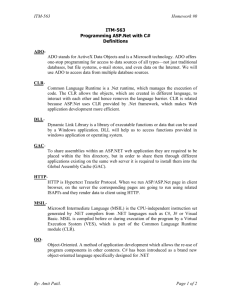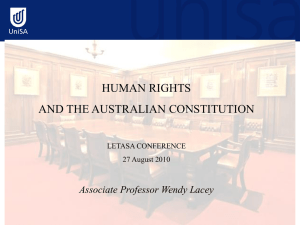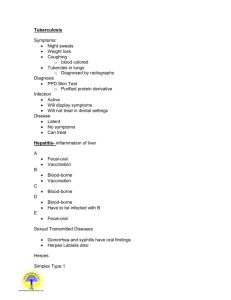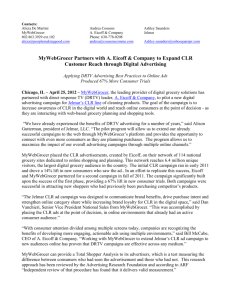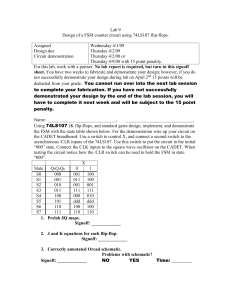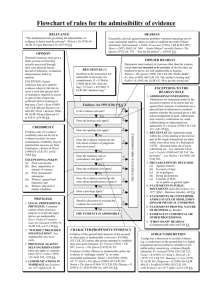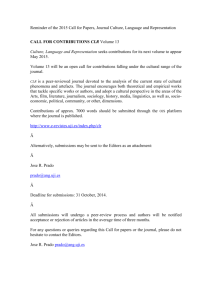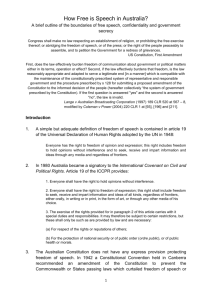AUSTRALIAN CONSTITUTIONAL LAW EXAMINATION
advertisement
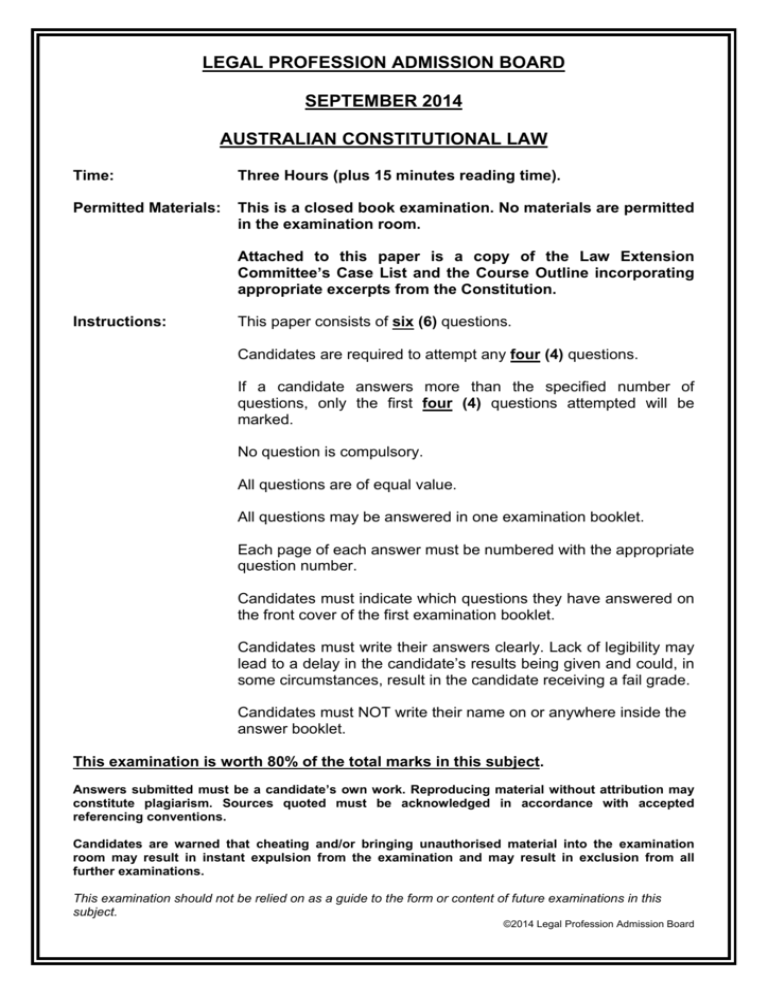
LEGAL PROFESSION ADMISSION BOARD SEPTEMBER 2014 AUSTRALIAN CONSTITUTIONAL LAW Time: Three Hours (plus 15 minutes reading time). Permitted Materials: This is a closed book examination. No materials are permitted in the examination room. Attached to this paper is a copy of the Law Extension Committee’s Case List and the Course Outline incorporating appropriate excerpts from the Constitution. Instructions: This paper consists of six (6) questions. Candidates are required to attempt any four (4) questions. If a candidate answers more than the specified number of questions, only the first four (4) questions attempted will be marked. No question is compulsory. All questions are of equal value. All questions may be answered in one examination booklet. Each page of each answer must be numbered with the appropriate question number. Candidates must indicate which questions they have answered on the front cover of the first examination booklet. Candidates must write their answers clearly. Lack of legibility may lead to a delay in the candidate’s results being given and could, in some circumstances, result in the candidate receiving a fail grade. Candidates must NOT write their name on or anywhere inside the answer booklet. This examination is worth 80% of the total marks in this subject. Answers submitted must be a candidate’s own work. Reproducing material without attribution may constitute plagiarism. Sources quoted must be acknowledged in accordance with accepted referencing conventions. Candidates are warned that cheating and/or bringing unauthorised material into the examination room may result in instant expulsion from the examination and may result in exclusion from all further examinations. This examination should not be relied on as a guide to the form or content of future examinations in this subject. ©2014 Legal Profession Admission Board Question 1 The Children’s Medical Research Institute (CMRI) is an incorporated body under the Corporations Act 2001 (Cth) and is a company limited by guarantee. The CMRI manages the Children’s Medical Research Foundation (CMRF), a charitable trust which is authorised to invest the money raised from fund raising to undertake children’s medical research and to use any income arising from these investments for the purposes of the CMRI. The CMRI has 161 staff and most of them are involved in the organisational arrangements for medical research. There are then five members of staff who actively manage and invest the money held by the CMRF. The capital sum is approximately $80 million. The process of investing and managing the investments is handled by those five members of staff without the use of external resources. The income generated by their investment activity returns 5% after payment of administration and management costs. Assume that the Commonwealth Parliament has introduced the Charitable Corporations Law Act 2014 which is stated to apply to all incorporated charitable bodies which are foreign corporations or trading or financial corporations formed within the Commonwealth. The Act creates a new supervisory body known as the Australian Charity Commission and also provides:− (a) the Board of Directors of an incorporated charitable body must contain at least two female directors; (b) an incorporated charitable body must furnish an annual report to the Australian Charity Commission disclosing its costs of administration and management; (c) the Australian Charity Commission must annually fix a salary cap on the remuneration to be paid to the chief executive officer of any incorporated charitable body. Is CMRI subject to the provisions of the Charitable Corporations Law Act 2014? Must CMRI comply with the specific provisions set out in (a), (b) and (c)? Advise CMRI. (Question 2 follows) 1 2 Question 2 Assume the Commonwealth Parliament decides to tackle the problem of pollution by introducing the Taxation of Pollution Act 2014. By ss 5 & 6 of the Act all mining and manufacturing companies operating within Australia must pay a “pollution reduction supervisory fee” to a new body created under s 3 of the Act known as the Pollution Commission Authority. The fees paid to the Pollution Commission Authority will be used by the Authority firstly to defray its operating expenses and secondly to monitor and provide practical guidance to each entity to reduce pollution by that entity. The Act goes on to provide, by s 10, for a flat tax of $500,000 on all mining companies operating in Australia. By s 12, the Act imposes a flat tax of $100,000 on all manufacturing companies which are operating in the urban areas of Sydney, Brisbane and Melbourne. By s 14 these taxes are payable by 1 October each year and failure to pay on time incurs a penalty of 10%. Under the Act the money collected is payable to the Consolidated Revenue Fund. Steely conducts mining operations in Queensland. Steely has evidence that the mining tax will actually be borne by mining companies in Queensland, Western Australia and New South Wales whereas other parts of Australia will not be impacted. Carparts operates a manufacturing company with business in urban Melbourne and it also consults you. Both Steely and Carparts wish to challenge the Commonwealth legislation. Advise Steely and Carparts on the validity of the provisions of the Taxation of Pollution Act 2014. Question 3 The Commonwealth Government and other countries negotiated a convention. The final document, executed by the signatory States (including Australia), provided a comprehensive scheme as follows. A list of human rights was arranged in a certain priority with varying sanctions: compliance was to be secured through education, conciliatory conferences or, in the last resort, the ordinary courts of the land. The Commonwealth Parliament recited the convention in the preamble to its Act. The sole provision in the Act repeated one of the listed rights, adjusting its terminology to that of the Australian federation as follows:− “The several electoral divisions within the Commonwealth or a State or Territorial electorate shall be, respectively and as nearly as practicable, equal in electors”. In his second reading speech on the Bill the responsible Minister explained that the provision was concerned with the statutory electoral divisions in Queensland which, the Minister claimed, differed from those in other States. Would the Commonwealth law, through s 109 of the Constitution, pre-empt the Queensland law? (Question 4 follows) 3 4 Question 4 The Australian Broadcasting Authority established under the Australian Broadcasting Services Act 1992 (Cth) is comprised of a Chairman, a judge of the Federal Court of Australia, and two other members all appointed for a term of five years. Recently the Authority heard a complaint in respect of “L” station on the basis that it was alleged that some of its broadcasters had been paid “cash for comment”: that is, the radio broadcasters were being paid fees by commercial undertakings to give favourable comment to a product without publicly disclosing the existence of substantial retainers to promote those products. In conducting these public hearings the Authority had power to compel witnesses to appear and give evidence under oath and produce documents to it. Under the statute the Authority had a duty to ensure that every person having an interest in the proceedings was given a reasonable opportunity to be heard. Failure to answer a question or produce a document, when required by the Authority, under the statute, constituted contempt and was punishable in proceedings before a single judge of the Federal Court of Australia. The Authority had power, under the statute, to revoke a broadcasting licence or impose conditions on any renewal of a licence and/or impose a fine where it found that a licensee had acted contrary to the public interest or had failed to have due regard to the interests of broadcasting. “L” station has held a commercial broadcasting licence for several years. The Authority following upon a public hearing made a determination to cancel “L” station’s licence and imposed a $10 million penalty. L station wishes to challenge the validity of these proceedings in the High Court alleging a denial of natural justice. Advise “L” station as to:− (a) The validity of the provisions of the Australian Broadcasting Services Act 1992 (Cth); and (b) The jurisdiction of the High Court to hear judicial review proceedings for the quashing of the Authority’s determinations (as to cancellation of its licence and imposition of a fine) on grounds of a denial of natural justice. Both (a) and (b) must be answered. (Question 5 follows) 5 6 Question 5 (a) To reduce air pollution the New South Wales Government introduces novel legislation: any vehicle operating on New South Wales roads shall use lead free petrol. Lead free petrol is available in New South Wales although not always conveniently; in some States, such as Queensland, lead free petrol is not available; and not all engines run satisfactorily on this kind of fuel; indeed most engines require a special contrivance in order to run on lead free petrol. (b) To reduce the road toll Victoria introduces novel legislation: no vehicle operating on Victorian roads shall exceed 30 kilometres an hour. Broadly the speed limits in Australia are: 60 km/h in built up areas and 100 km/h outside these areas. X is engaged in the interstate transport of fresh fruit from producers in Queensland to supermarkets in New South Wales and in Victoria. X wishes to challenge both the NSW law and the Victorian law. Advise X as to both enactments. Question 6 (a) Assume the Federal Parliament introduces a Payroll Tax Act which is expressed to bind the Crown in the right of the State. The Act imposes a tax levy of 1% on all payrolls in excess of $200,000 per annum. The New South Wales Government can establish that it bears the largest financial burden of all taxpayers liable to pay the Commonwealth payroll tax. The burden is so significant that the government is obliged to cut services to pay the tax. Advise the New South Wales Government whether it is obliged to pay the payroll tax. (b) Assume the New South Wales Parliament introduces a Payroll Tax Act which is expressed to bind the Crown in the right of the Commonwealth. The Act imposes a tax levy of 1% on all payrolls in excess of $200,000 per annum. The Commonwealth Government can establish that it bears the largest financial burden of all taxpayers liable to pay the Commonwealth payroll tax. The burden is so significant that the government is obliged to cut services to pay the tax. The Commonwealth seeks your advice on (i) whether it is obliged to pay the New South Wales payroll tax and (ii) whether it can avoid the tax. Advise the Commonwealth Government. Parts (a) and (b) must both be answered. END OF PAPER 7 8 CASE LIST 1. Introduction Amalgamated Society of Engineers v Adelaide Steamship Co Ltd (“Engineers' Case”) (1920) 28 CLR 129 Leask v Commonwealth (1996) 187 CLR 579 Melbourne Corporation v Commonwealth (“Melbourne Corporation Case”) (1947) 74 CLR 31 Murphyores Inc Pty Ltd v Commonwealth (1976) 136 CLR 1 Austin v Commonwealth (2003) 215 CLR 185 2. Trade and commerce power: Constitution, s 51(i) A-G (WA) v Australian National Airlines Commission (“Ansett Transport Industries Case”) (1976) 138 CLR 492 Airlines of New South Wales v New South Wales (No 2) (“Second Airlines Case”) (1965) 113 CLR 54 Australian National Airways v Commonwealth (1945) 71 CLR 29 Huddart Parker v Commonwealth (1931) 44 CLR 492 Murphyores Inc v Commonwealth (1976) 136 CLR 1 O'Sullivan v Noarlunga Meat (1954) 92 CLR 565 R v Foster: ex parte Eastern and Australian Steamship Co (1959) 103 CLR 256 Redfern v Dunlop Rubber Australia (“Redfern's Case”) (1964) 110 CLR 194 Wragg v New South Wales (1953) 88 CLR 353 3a. Taxation power: Constitution, s 51(ii) Air Caledonie International v Commonwealth (1988) 165 CLR 462 Austin v Commonwealth (2003) 215 CLR 185 Australian Tape Manufacturers Association v Commonwealth (“Blank Tape Royalty Case”) (1993) 176 CLR 480 Elliott v Commonwealth (1936) 54 CLR 657 Fairfax v FCT (1965) 114 CLR 1 Fortescue Metals Group Ltd v Commonwealth [2013] HCA 34 (7 August 2013) Harper v Minister for Sea Fisheries (1989) 168 CLR 314 Logan Downs v FCT (1965) 112 CLR 177 Northern Suburbs General Cemetery Reserve Trust v Commonwealth (“Training Guarantee Case”) (1993) 176 CLR 555 Osborne v Commonwealth (1911) 12 CLR 321 Pape v Federal Commissioner of Taxation (2009) 238 CLR 1 R v Barger (1908) 6 CLR 41 Roy Morgan Research Pty Ltd v Commissioner of Taxation (2011) 244 CLR 97 South Australia v Commonwealth (First Uniform Tax Case) (1942) 65 CLR 373 Victoria v Commonwealth (Second Uniform Tax Case) (1957) 99 CLR 575 3b. Provisions in taxation laws: Constitution, s 55 Air Caledonie International v Commonwealth (1988) 165 CLR 462 Australian Tape Manufacturers Association v Commonwealth (1993) 176 CLR 480 Cadbury-Fry-Pascall v FCT (1944) 70 CLR 362 Collector of Customs (NSW) v Southern Shipping Co (1962) 107 CLR 279 Luton v Lessels (2002) 210 CLR 333 Permanent Trustee Australia Pty Ltd v Commissioner of State Revenue (2004) 220 CLR 388 (pars 55-74) Re Dymond (1959) 101 CLR 11 State Chamber of Commerce and Industry v Commonwealth (Fringe Benefits Tax Case) (1987) 163 CLR 329 9 4. Corporations power: Constitution, s 51(xx) Actors and Announcers Equity Association of Australia v Fontana Films (“Actors Equity Case”) (1982) 150 CLR 169 Commonwealth v Tasmania (“Tasmanian Dam Case”) (1983) 158 CLR 1 Re Dingjan; ex parte Wagner (“Dingjan's Case”) (1995) 183 CLR 323 Fencott v Muller (1983) 152 CLR 570 New South Wales v Commonwealth (“Incorporation Case”) (1990) 169 CLR 482 New South Wales v Commonwealth; Western Australia v Commonwealth (2006) 229 CLR 1 (“Work Choices Case”) R v Australian Industrial Court: ex parte C L M Holdings (1977) 136 CLR 235 R v Federal Court of Australia: ex parte Western Australian National Football League (“Adamson's Case”) (1979) 143 CLR 190 State Superannuation Board v Trade Practices Commission (1982) 150 CLR 282 Strickland v Rocla Concrete Pipes (“Concrete Pipes Case”) (1971) 124 CLR 468 Victoria v Commonwealth (“Industrial Relations Act Case”) (1996) 187 CLR 416 5. External affairs power: Constitution, s 51(xxix) Airlines of New South Wales v New South Wales (No 2) (“Airlines No 2”) (1965) 113 CLR 54 Bradley v Commonwealth (1973) 128 CLR 557 Commonwealth v Tasmania (“Tasmanian Dam Case”) (1983) 158 CLR 1 Koowarta v Bjelke-Petersen (1982) 153 CLR 168 New South Wales v Commonwealth (“Seas and Submerged Lands Act Case”) (1975) 135 CLR 337 Pape v Federal Commissioner of Taxation (2009) 238 CLR 1 Polyukhovich v Commonwealth (“War Crimes Act Case”) (1991) 172 CLR 501 Queensland v Commonwealth (“Tropical Rainforest Case”) (1989) 167 CLR 232 R v Burgess: ex parte Henry (1936) 55 CLR 608 R v Poole: ex parte Henry (No 2) (1939) 61 CLR 634 Richardson v The Forestry Commission (1988) 164 CLR 261 Victoria v Commonwealth (“Industrial Relations Act Case”) (1996) 187 CLR 416 6a. Executive power Constitution, s 61 Pape v Federal Commissioner of Taxation (2009) 238 CLR 1 Victorian Stevedoring and General Contracting Co and Meakes v Dignan (1931) 46 CLR 73 Williams v Commonwealth (2012) 86 ALJR 713 6b. Separation of powers: Constitution, s 71 Harris v Caladine (1991) 172 CLR 84 Hilton v Wells (1985) 157 CLR 57 R v Joske: ex parte Australian Building Construction Employees and Builders Labourers Federation (1974) 130 CLR 87 The Boilermakers Case (1956) 94 CLR 254; (1957) 95 CLR 529 Waterside Workers Federation of Australia v J W Alexander (1918) 25 CLR 434 Wilson v Minister for Aboriginal and Torres Strait Islander Affair (1996) 189 CLR 1 7. Judicial power of the Commonwealth: Constitution, s 71 Attorney-General (Cth) v Breckler (1999) 197 CLR 83 Attorney-General (Cth) v Alinta (2008) 233 CLR 542 Brandy v Human Rights and Equal Opportunity Commission (“Brandy's Case”) (1995) 183 CLR 245 Cominos v Cominos (1972) 127 CLR 588 Farbenfabriken Bayer Aktiengesellschaft v Bayer Pharma (1959) 101 CLR 652 Huddart Parker v Moorehead (1909) 8 CLR 330 Lane v Morrison (2009) 239 CLR 230 Precision Data Holdings v Wills (1991) 173 CLR 167 10 R v Commonwealth Industrial Court: ex parte Amalgamated Engineering Union Australian Section (“Shearer's Case”) (1960) 103 CLR 368 R v Davison (1954) 90 CLR 353 R v Joske: ex parte Australian Building Construction Employees and Builders Labourers Federation (1974) 130 CLR 87 R v Quinn: ex parte Consolidated Foods (1977) 138 CLR 1 R v Spicer: ex parte Australian Builders Labourers Federation (1957) 100 CLR 277 R v Spicer: ex parte Waterside Workers Federation of Australia (1957) 100 CLR 312 R v Trade Practices Tribunal: ex parte Tasmanian Breweries (1970) 123 CLR 361 Re Tracey: ex parte Ryan (1989) 166 CLR 518 Rola Co (Australia) v Commonwealth (1944) 69 CLR 185 Thomas v Mowbray (2007) 233 CLR 307 8a. Courts and federal jurisdiction: Constitution, s 71 R v Bevan: ex parte Elias (1942) 66 CLR 452 In re Judiciary and Navigation Acts (1921) 29 CLR 257 Re Wakim; ex parte McNally (1999) 198 CLR 511 R v Hickman; ex parte Fox and Clinton (1945) 70 CLR 598 The Marriage Act Case (1962) 107 CLR 529 8b. High Court's appellate jurisdiction: Constitution, s 73 Cockle v Isaksen (1957) 99 CLR 155 Mellifont v A-G (Q) (1991) 173 CLR 289 O'Toole v Charles David (1990) 171 CLR 232 Smith Kline and French Laboratories (Australia) v Commonwealth (1991) 173 CLR 194 8c. High Court's original jurisdiction: Constitution, ss 75, 76 (1) Section 75(iii) Bank of New South Wales v Commonwealth (1948) 76 CLR 1 Inglis v Commonwealth Trading Bank (1969) 119 CLR 334 R v Collins: ex parte ACTU-Solo Enterprises (1976) 50 ALJR 471 Repatriation Commission v Kirkland (1923) 32 CLR 1 Toowoomba Foundry v Commonwealth (1945) 71 CLR 545 (2) Section 75(v) Bodruddaza v Minister for Immigration and Multicultural Affairs (2007) 228 CLR 651 Plaintiff S157/2002 v Commonwealth of Australia (2003) 211 CLR 476 R v Cook; ex parte Twigg (1980) 147 CLR 15 R v Drake-Brockman: ex parte National Oil (1943) 68 CLR 51 R v Murray: ex parte Commonwealth (1916) 22 CLR 437 Re Refugee Review Tribunal; Ex parte Aala (2000) 204 CLR 82 (3) Section 76(i) A-G (NSW) v Commonwealth Savings Bank (1986) 160 CLR 315 James v South Australia (1927) 40 CLR 1 (4) Section 76(ii) Felton v Mulligan (1971) 124 CLR 367 R v Commonwealth Court of Conciliation and Arbitration: ex parte Barrett (1945) 70 CLR 141 Watson v FCT (1953) 87 CLR 353 11 8d. Investing State courts with federal jurisdiction: Constitution, s 77(iii) Commonwealth v Hospital Contribution Fund of Australia (1982) 150 CLR 49 Harris v Caladine (1991) 172 CLR 84 (s77(ii)) Kable v Director of Public Prosecutions NSW (1996) 189 CLR 51 9a. Duties of excise: Constitution, s 90 Capital Duplicators v Australian Capital Territory (No 2) (1993) 178 CLR 561 Dennis Hotels v Victoria (1960) 104 CLR 529 Dickenson's Arcade v Tasmania (1974) 130 CLR 177 Gosford Meats v New South Wales (1985) 155 CLR 368 Ha v New South Wales (1997) 189 CLR 465 H C Sleigh v South Australia (1977) 136 CLR 475 Harper v Minister for Sea Fisheries (1989) 168 CLR 314 Harper v Victoria (1966) 114 CLR 361 Hematite Petroleum v Victoria (1983) 151 CLR 599 Logan Downs v Queensland (1977) 137 CLR 59 Matthews v Chicory Marketing Board (Victoria) (1938) 60 CLR 263 Parton v Milk Board (Victoria) (1949) 80 CLR 263 9b. Freedom of inter-state trade: Constitution, s 92 Barley Marketing Board (NSW) v Norman (1990) 171 CLR 182 Bath v Alston Holdings (1988) 165 CLR 411 Betfair Pty Ltd v Western Australia (2008) 234 CLR 418 Castlemaine Tooheys v South Australia (1990) 169 CLR 436 Cole v Whitfield (1988) 165 CLR 360 Sportsbet Pty Ltd v New South Wales [2012] HCA 13 (2012) 86 ALJR 446 10. Implied freedom of political communication Aust Capital Television v Commonwealth (No 2) (1992) 177 CLR 106 Coleman v Power (2004) 220 CLR 1 Lange v Australian Broadcasting Corp (1997) 189 CLR 520 Nationwide News v Wills (1992) 177 CLR 1 Unions NSW v New South Wales [2013] HCA 58 (2013) 88 ALJR 227 Wotton v State of Queensland (2012) 246 CLR 1 11. Inconsistency of laws: Constitution, s 109 Airlines of New South Wales v New South Wales (No 2) (“Second Airlines Case”) (1965) 113 CLR 54 Ansett Transport Industries (Operations) v Wardley (1980) 142 CLR 237 Clyde Engineering Co v Cowburn (1926) 37 CLR 466 Colvin v Bradley Bros (1943) 68 CLR 151 Commercial Radio Coffs Harbour v Fuller (1986) 161 CLR 47 Dickson v The Queen (2010) 241 CLR 491 Ex parte McLean (1930) 43 CLR 472 O'Sullivan v Noarlunga Meat (1954) 92 CLR 565 R v Credit Tribunal: ex parte General Motors Acceptance Corporation, Australia (1977) 137 CLR 545 Viskauskas v Niland (1983) 153 CLR 280 Wenn v A-G (Vic) (1948) 77 CLR 84 Wollongong University v Metwally (1984) 158 CLR 447 12 12. Commonwealth – State relations Amalgamated Society of Engineers v The Adelaide Steamship Co (“Engineers Case”) (1920) 28 CLR 129 Austin v Commonwealth (2003) 215 CLR 185 Australian Coastal Shipping Commission v O'Reilly (1962) 107 CLR 46 Clarke v Federal Commissioner of Taxation (2009) 258 CLR 272 Commonwealth v Cigamatic (1962) 108 CLR 372 Commonwealth v Tasmania (“Tasmanian Dam Case”) (1983) 158 CLR 1 Melbourne Corporation v Commonwealth (Melbourne Corporation Case”) (1947) 74 CLR 31 Pirrie v McFarlane (1925) 36 CLR 170 Queensland Electricity Commission v Commonwealth (1985) 159 CLR 192 Re The Residential Tenancies Tribunal of NSW and Henderson; Ex parte The Defence Housing Authority (“Hendersons Case”) (1997) 190 CLR 410 Victoria v Commonwealth (1971) (“Payroll Tax Case”) 122 CLR 353 West v Commissioner of Taxation (1937) 56 CLR 657 13 COURSE OUTLINE Introduction 1. The Constitution General considerations Approaches to interpretation and characterisation:a. b. c. scope of head of power characterisation restrictions Federal powers 2. Trade and commerce power: Constitution, s 51(i) s 51: “The Parliament shall, subject to this Constitution, have power to make laws for the peace order and good government of the Commonwealth with respect to: (i) Trade and commerce with other countries, and among the States.” a. b. c. d. Understanding what is “trade and commerce” Overseas trade and commerce Interstate trade and commerce Regulation of intrastate trade and commerce 3a. Taxation power: Constitution, s 51(ii) s 51: “The Parliament shall, subject to this Constitution, have power to make laws for the peace order and good government of the Commonwealth with respect to: … (ii) taxation; but so as not to discriminate between States or parts of States: …” a. b. c. d. Identification of tax Characterisation of tax laws Revenue or regulation Meaning of discrimination and preference 3b. Provisions in taxation laws: Constitution, s 55 s 55: Tax Bills “Laws imposing taxation shall deal only with the imposition of taxation, and any provision therein dealing with any other matter shall be of no effect. Laws imposing taxation, except laws imposing duties of customs or of excise, shall deal with one subject of taxation only; but laws imposing duties of customs shall deal with duties of customs only, and laws imposing duties of excise shall deal with duties of excise only.” a. b. Operation of the two limbs of s 55 Consequences of breach of s 55 14 4. Corporations power: Constitution, s 51(xx) s 51: “The Parliament shall, subject to this Constitution, have power to make laws for the peace order and good government of the Commonwealth with respect to: … (xx) foreign corporations, and trading and financial corporations formed within the limits of the Commonwealth: ….” a. b. c. d. e. Identification of corporation as “trading” and/or “financial” corporation Ambit of power Incorporation case Liquidation Incidental scope of power 5. External affairs power: Constitution, s 51(xxix) s 51: “The Parliament shall, subject to this Constitution, have power to make laws for the peace order and good government of the Commonwealth with respect to: … (xxix) External affairs: …” a. b. c. d. e. f. g. h. Matters within "external affairs"; relations with other countries; matters external to Australia; international law Treaties and Conventions Subject matter of treaty; historically the differing views Implementing the treaty into municipal law Obligations and/or recommendations Relationship between treaty and municipal law Possible limitations Matters of international concern 6. Separation of powers s 1: “The legislative power of the Commonwealth shall be vested in a Federal Parliament…” s 61: “The executive power of the Commonwealth is vested in the Queen and is exercisable by the Governor-General as the Queen’s representative, and extends to the execution and maintenance of this Constitution, and of the laws of the Commonwealth.” s 71: "The judicial power of the Commonwealth shall be vested in a Federal Supreme Court, to be called the High Court of Australia, and in such other federal courts as the Parliament creates, and in such other courts as it invests with federal jurisdiction ...." Boilermakers’ case and its significance: Constitution, s 71 Executive power of the Commonwealth: Constitution, s 61 a. b. General considerations Width of power to delegate legislative authority to executive 15 7. Judicial power of the Commonwealth: Constitution, s 71 s 71: "The judicial power of the Commonwealth shall be vested in a Federal Supreme Court, to be called the High Court of Australia, and in such other federal courts as the Parliament creates, and in such other courts as it invests with federal jurisdiction ...." s 72: “…The Justices of the High Court and of the other courts created by Parliament – (i) Shall be appointed by… (ii) Shall not be removed … (iii) Shall receive such remuneration… The appointment of a Justice of the High Court shall be for a term expiring upon his attaining the age of seventy years, and a person shall not be appointed as a Justice of the High Court if he has attained that age. The appointment of a Justice of a court created by the Parliament shall be for a term expiring upon his attaining the age that is, at the time of his appointment, the maximum age for Justices of that court and a person shall not be appointed as a Justice of such a court if he has attained the age that is for the time being the maximum age for Justices of that court. Subject to this section, the maximum age for Justices of any court created by the Parliament is seventy years. The Parliament may make a law fixing an age that is less than seventy years as the maximum age for Justices of a court created by Parliament and may at any time repeal or amend such a law, but any such repeal or amendment does not affect the term of office of a Justice under appointment made before the repeal or amendment. …” a. Identification of judicial power of the Commonwealth. b. Factors to distinguish it from non-judicial power c. Exceptions to Boilermakers – power to delegate; designated person rule; other exceptions d. Significance of Boilermakers e. Practical consequences of separation of powers The judicature: Constitution, Ch III 8. Federal jurisdiction: Constitution, s 71 a. b. Nature of "federal jurisdiction" Nature of "matter" High Court's appellate jurisdiction: Constitution, s 73 s 73: “The High Court shall have jurisdiction, with such exceptions and subject to such regulations as the Parliament prescribes, to hear and determine appeals from all judgments, decrees, orders, and sentences(i) (ii) (iii) Of any Justice or Justices exercising the original jurisdiction of the High Court; Of any other federal court, or court exercising federal jurisdiction; or of the Supreme Court of any State, or of any other court of any State from which at the establishment of the Commonwealth an appeal lies to the Queen in Council; Of the Inter-State Commission, but as to questions of law only; 16 and the judgment of the High Court in all such cases shall be final and conclusive. But no exception or regulation prescribed by the Parliament shall prevent the High Court from hearing and determining any appeal from the Supreme Court of a State in any matter in which at the establishment of the Commonwealth an appeal lies from such Supreme Court to the Queen in Council. Until the Parliament otherwise provides, the conditions of and restrictions on appeals to the Queen in Council from the Supreme Courts of the several States shall be applicable to appeals from them to the High Court.” a. b. Prerequisites for s 73 jurisdiction Parliamentary power to make exceptions and regulate High Court's original jurisdiction: Constitution, s 75(iii) and s 75(v); s 76(i) and s 76(ii) s 75: “In all matters … (iii) In which the Commonwealth, or a person suing or being sued on behalf of the Commonwealth, is a party … the High Court shall have original jurisdiction. … (v) In which a writ of Mandamus or prohibition or an injunction is sought against an officer of the Commonwealth … the High Court shall have original jurisdiction.” s 76: “The Parliament may make laws conferring original jurisdiction on the High Court in any matter … (i) Arising under this Constitution or involving its interpretation. (ii) Arising under any laws made by the Parliament.” a. b. 75(iii) c. d. s 76(i) e. Sections 75-76 specialised original jurisdiction "Commonwealth" or person within extended phrase "being sued . . ." in s "Officer of the Commonwealth" and relevant remedies under s 75(v) Matter "arising under or involving the interpretation of the Constitution" within When a matter "arises" within s 76(ii) Power to define jurisdiction: Constitution, s 77 s 77: “With respect to any of the matters mentioned in the last two sections the Parliament may make laws: (i) (ii) Defining the jurisdiction of any federal court other than the High Court: Defining the extent to which the jurisdiction of any federal court shall be exclusive of that which belongs to or is vested in the courts of the States: Investing any Court of a State with federal jurisdiction.” (iii) a. b. c. "Any court of a State" Role of administrative officers and implications of Harris v Caladine Repository of federal judicial power - Kable v DPP Prohibitions 9a. Prohibition of a State from imposing duties of excise etc: Constitution, s 90 17 s 90: “On the imposition of uniform duties of customs the power of the Parliament to impose duties of customs and of excise, and to grant bounties on the production or export of goods, shall become exclusive …” a. b. c. d. e. f. "Excise duty" What is a duty of excise? The history. What is excluded? Reason s90 included in Constitution The Dennis Hotels anomaly and restrictions on it The broad view has triumphed 9b. "Absolute freedom" of trade, commerce and intercourse: Constitution, s 92: s 92: “On the imposition of uniform duties of customs, trade, commerce, and intercourse among the States, whether by means of internal carriage or ocean navigation, shall be absolutely free…” a. b. c. d. The fresh start to the interpretation of s 92 in Cole v Whitfield The application of the fresh start Absolutely free and legitimate local interest Marketing legislation Implied freedom 10a. The implied freedom of communication a. b. c. Freedom of political discussion The Lange modifications Broad view of political discussion Federalism 11. Inconsistency between Commonwealth and State laws: Constitution, s 109 s 109: “When a law of a State is inconsistent with a law of the Commonwealth, the latter shall prevail, and the former shall, to the extent of the inconsistency, be invalid.” a. b. c. "Laws" "Invalid" "Inconsistency" 12. Commonwealth-State relations a. Power of the Commonwealth and the States to make laws binding on each other b. Commonwealth regulation of States c. State regulation of Commonwealth d. Does Commonwealth have any general immunity? Commonwealth subjecting itself to State laws 18
